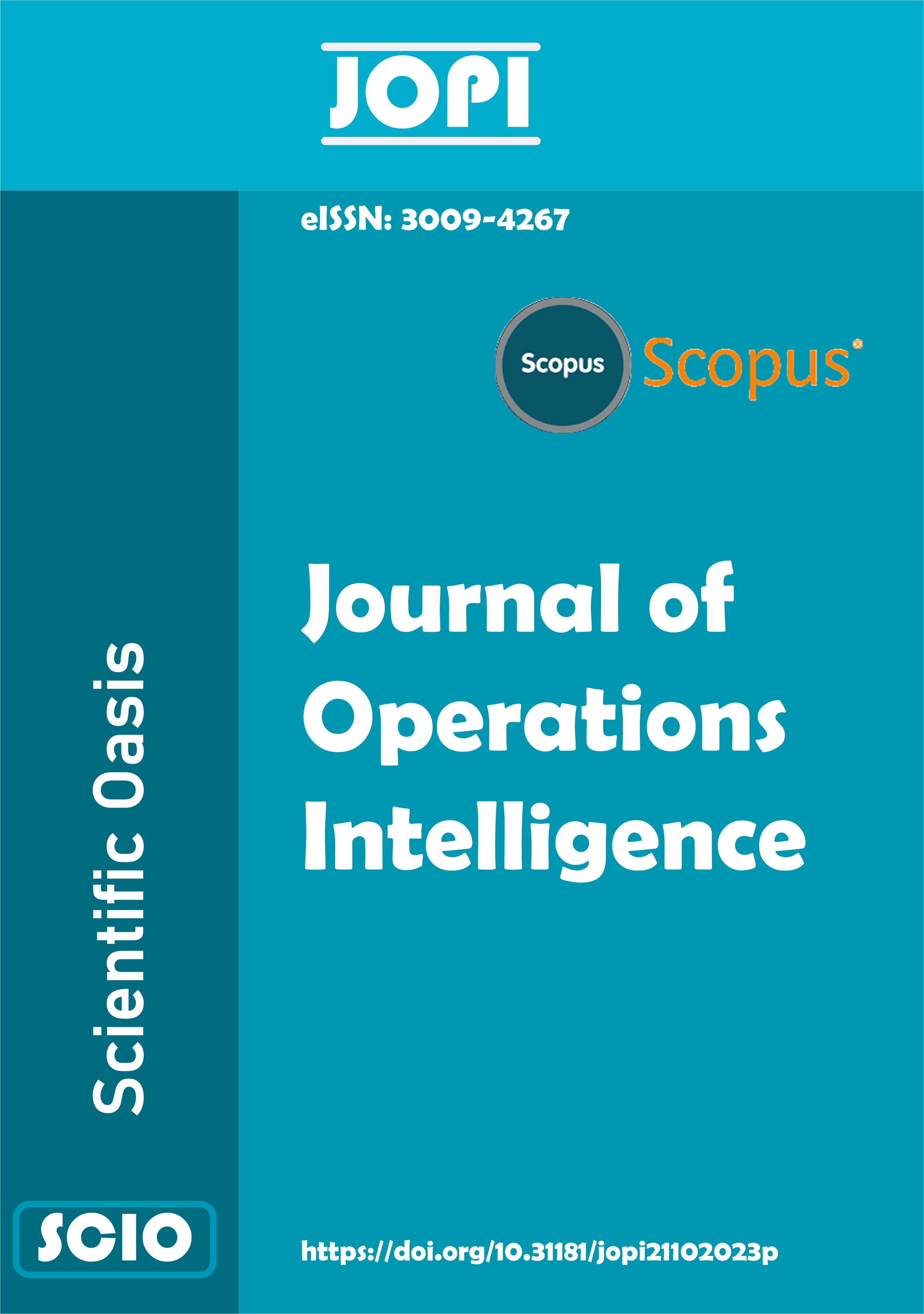Offshore Wind Power Site Selection in Türkiye Using q-Rung Orthopair Fuzzy Sets and the COPRAS Method
DOI:
https://doi.org/10.31181/jopi31202551Keywords:
Offshore wind farm, Wind energy, Site selection, q-Rung Orthopair fuzzy sets, COPRAS method, Renewable energyAbstract
Wind energy has significant potential for electricity and energy generation. At the same time, Türkiye is among the important markets in wind energy production worldwide. With the increasing energy demand and sustainability goals, energy production is gradually shifting towards offshore wind farms (OWFs). In this study, three alternative locations in the Aegean Sea region of Türkiye were evaluated to determine the most suitable site for OWF installation based on two main and twelve sub-criteria. The methodology applied in the study generally consists of four stages. In the first stage, a normalized weighted decision matrix was created using the steps of the q-rung Orthopair fuzzy set. In the second stage, the COPRAS method, one of the multi-criteria decision-making (MCDM) methods, was applied to rank the alternatives, and the best alternative was determined to be Bozcaada offshore. In the third stage, a comparison analysis was performed using q-ROF TOPSIS and q-ROF WASPAS methods. As a result of the comparison analysis, it was determined that all three methods gave the same results. In the last stage, the sensitivity of all three MCDM methods was checked by changing the q levels. The sensitivity analysis revealed that the q-ROF COPRAS method was insensitive to changes in q levels, while the q-ROF TOPSIS and q-ROF WASPAS methods were sensitive, as the alternative rankings changed as a result of these changes.
Downloads
References
Caceoğlu, E., Yildiz, H. K., Oğuz, E., Huvaj, N., & Guerrero, J. M. (2022). Offshore wind power plant site selection using Analytical Hierarchy Process for Northwest Turkey. Ocean engineering, 252, 111178. https://doi.org/10.1016/j.oceaneng.2022.111178.
International Energy Agency (IEA). (2019). Offshore wind outlook 2019: World energy outlook special report. Offshore Wind Outlook 2019 – Analysis - IEA.
Deveci, M., Özcan, E., John, R., Pamucar, D., & Karaman, H. (2021). Offshore wind farm site selection using interval rough numbers based Best-Worst Method and MARCOS. Applied Soft Computing, 109, 107532. https://doi.org/10.1016/j.asoc.2021.107532.
Esteban, M. D., Diez, J. J., López, J. S., & Negro, V. (2011). Why offshore wind energy? Renewable Energy, 36(2), 444–450. https://doi.org/10.1016/j.renene.2010.07.009.
Wang, S., & Wang, S. (2015). Impacts of wind energy on environment: A review. Renewable and Sustainable Energy Reviews, 49, 437–443. https://doi.org/10.1016/j.rser.2015.04.137.
Kim, C. K., Jang, S., & Kim, T. Y. (2018). Site selection for offshore wind farms in the southwest coast of South Korea. Renewable Energy, 120, 151–162. https://doi.org/10.1016/j.renene.2017.12.081.
Tercan, E., Tapkın, S., Latinopoulos, D., Dereli, M. A., Tsiropoulos, A., & Ak, M. F. (2020). A GIS-based multi-criteria model for offshore wind energy power plants site selection in both sides of the Aegean Sea. Environmental Monitoring and Assessment, 192(5), 1-20. https://doi.org/10.1007/s10661-020-08603-9.
Satir, M., Murphy, F., & McDonnell, K. (2018). Feasibility study of an offshore wind farm in the Aegean Sea, Turkey. Renewable and Sustainable Energy Reviews, 81, 2552–2562. https://doi.org/10.1016/j.rser.2017.06.063.
Sun, X., Huang, D., & Wu, G. (2012). The current state of offshore wind energy technology development. Energy, 41(1), 298–312. https://doi.org/10.1016/j.energy.2012.02.054.
Staffell, I., & Green, R. (2014). How does wind farm performance decline with age? Renewable Energy, 66, 775–786. https://doi.org/10.1016/j.renene.2013.10.041.
Röckmann, C., Lagerveld, S., & Stavenuiter, J. (2017). Operation and maintenance costs of offshore wind farms and potential multi-use platforms in the Dutch North Sea. In B. Buck & R. Langan (Eds.), Aquaculture perspective of multi-use sites in the open ocean, 97–113. Springer. https://doi.org/10.1007/978-3-319-51159-7_7.
Wind Europe. (2021). Offshore Wind in Europe – Key Trends and Statistics 2020. Wind Europe. https://www.connaissancedesenergies.org/sites/default/files/pdf-actualites/WindEurope-Offshore-wind-in-Europe-statistics-2020.pdf. (Accessed 20 May 2025).
Caglayan, D. G., Ryberg, D. S., Heinrichs, H., Linßen, J., Stolten, D., & Robinius, M. (2019). The techno-economic potential of offshore wind energy with optimized future turbine designs in Europe. Applied Energy, 255, 113794. https://doi.org/10.1016/j.apenergy.2019.113794.
WindEurope. (2024). Annual report 2024. https://windeurope.org/intelligence-platform/product/wind-energy-in-europe-2024-statistics-and-the-outlook-for-2025-2030/. (Accessed 21 May 2025).
T.C. Enerji ve Tabii Kaynaklar Bakanlığı. (2024). https://enerji.gov.tr/bilgi-merkezi-enerji-ruzgar. (Accessed 21 May 2025).
TEİAŞ (2024). Türkiye Elektrik İletim A.Ş. 2024–2034 Projeksiyon Raporu. https://www.teias.gov.tr/ilgili-raporlar. (Accessed 21 May 2025).
Umoh, K., Hasan, A., & Kenjegaliev, A. (2025). Combined AHP-GIS methodology for floating offshore wind site selection in South Africa. Ocean Engineering, 317, 120037. https://doi.org/10.1016/j.oceaneng.2024.120037.
Dash, S., Chakravarty, S., Giri, N. C., & Khargotra, R. (2025). Evaluating sustainable wind energy sources with multiple criteria decision-making (MCDM) techniques. Computers and Electrical Engineering, 123, 110285. https://doi.org/10.1016/j.compeleceng.2025.110285.
Li, X., Xu, L., Cai, J., Peng, C., & Bian, X. (2024). Offshore wind turbine selection with multi-criteria decision-making techniques involving D numbers and squeeze adversarial interpretive structural modeling method. Applied Energy, 368, 123381. https://doi.org/10.1016/j.apenergy.2024.123381.
Solbrekke, I. M., & Sorteberg, A. (2024). Norwegian offshore wind power—spatial planning using multi‐criteria decision analysis. Wind Energy, 27(1), 5-32. https://doi.org/10.1002/we.2871.
Martinez, A., & Iglesias, G. (2024). Techno-economic assessment of potential zones for offshore wind energy: A methodology. Science of The Total Environment, 909, 168585. https://doi.org/10.1016/j.scitotenv.2023.168585.
Önden, İ., Kara, K., Yalçın, G. C., Deveci, M., Önden, A., & Eker, M. (2024). Strategic location analysis for offshore wind farms to sustainably fulfill railway energy demand in Turkey. Journal of Cleaner Production, 434, 140142. https://doi.org/10.1016/j.jclepro.2023.140142.
Faraggiana, E., Ghigo, A., Sirigu, M., Petracca, E., Giorgi, G., Mattiazzo, G., & Bracco, G. (2024). Optimal floating offshore wind farms for Mediterranean islands. Renewable Energy, 221, 119785. https://doi.org/10.1016/j.renene.2023.119785.
Ziemba, P. (2022). Uncertain multi-criteria analysis of offshore wind farms projects investments–Case study of the Polish Economic Zone of the Baltic Sea. Applied Energy, 309, 118232. https://doi.org/10.1016/j.apenergy.2021.118232.
Hou, G., Xu, K., & Lian, J. (2022). A review on recent risk assessment methodologies of offshore wind turbine foundations. Ocean Engineering, 264, 112469. https://doi.org/10.1016/j.oceaneng.2022.112469.
Gkeka-Serpetsidaki, P., & Tsoutsos, T. (2022). A methodological framework for optimal siting of offshore wind farms: A case study on the island of Crete. Energy, 239, 122296. https://doi.org/10.1016/j.energy.2021.122296.
Liu, Q., Sun, Y., & Wu, M. (2021). Decision-making methodologies in offshore wind power investments: A review. Journal of Cleaner Production, 295, 126459. https://doi.org/10.1016/j.jclepro.2021.126459.
De Salvo, M., Notaro, S., Cucuzza, G., Giuffrida, L., & Signorello, G. (2021). Protecting the local landscape or reducing greenhouse gas emissions? A study on social acceptance and preferences towards the installation of a wind farm. Sustainability, 13(22), 12755. https://doi.org/10.3390/su132212755.
Shao, M., Han, Z., Sun, J., Xiao, C., Zhang, S., & Zhao, Y. (2020). A review of multi-criteria decision making applications for renewable energy site selection. Renewable Energy, 157, 377-403. https://doi.org/10.1016/j.renene.2020.04.137.
Díaz, H., & Soares, C. G. (2020). An integrated GIS approach for site selection of floating offshore wind farms in the Atlantic continental European coastline. Renewable and Sustainable Energy Reviews, 134, 110328. https://doi.org/10.1016/j.rser.2020.110328.
Xu, Y., Li, Y., Zheng, L., Cui, L., Li, S., Li, W., & Cai, Y. (2020). Site selection of wind farms using GIS and multi-criteria decision-making method in Wafangdian, China. Energy, 207, 118222. https://doi.org/10.1016/j.energy.2020.118222.
Deveci, M., Pamucar, D., Cali, U., Kantar, E., Kölle, K., & Tande, J. O. (2022). Hybrid q-rung orthopair fuzzy sets based CoCoSo model for floating offshore wind farm site selection in Norway. CSEE Journal of Power and Energy Systems, 8(5), 1261-1280. https://doi.org/10.17775/CSEEJPES.2021.07700.
Díaz, H., Loughney, S., Wang, J., & Soares, C. G. (2022). Comparison of multicriteria analysis techniques for decision making on floating offshore wind farms site selection. Ocean Engineering, 248, 110751. https://doi.org/10.1016/j.oceaneng.2022.110751.
Gahramanov, R., & Beji, S. (2023). Site selection and capacity determination of potential offshore wind farm in western Black Sea region of Turkiye. International Journal of Environment and Geoinformatics, 10(2), 101-109. https://doi.org/10.30897/ijegeo.1265116.
Konurhan, Z., Yücesan, M., & Gül, M. (2023). An integrated Bayesian Best-Worst Method and GIS-based approach for offshore wind power plant site selection: A case study in North Aegean and Marmara Sea (Türkiye). Türk Coğrafya Dergisi, (82), 7-22. https://doi.org/10.17211/tcd.1214671.
Hosseinzadeh, S., Etemad-Shahidi, A., & Stewart, R. A. (2023). Site selection of combined offshore wind and wave energy farms: a systematic review. Energies, 16(4), 2074. https://doi.org/10.3390/en16042074.
Barzehkar, M., Parnell, K., Soomere, T., & Koivisto, M. (2024). Offshore wind power plant site selection in the Baltic Sea. Regional Studies in Marine Science, 73, 103469. https://doi.org/10.1016/j.rsma.2024.103469.
Cali, U., Kantar, E., Pamucar, D., Deveci, M., Taylor, P., Campos-Gaona, D., & Tande, J. O. (2024). Offshore wind farm site selection in Norway: Using a fuzzy trigonometric weighted assessment model. Journal of Cleaner Production, 436, 140530. https://doi.org/10.1016/j.jclepro.2023.140530.
Dimitriou, I. C., Sarmas, E., Trachanas, G. P., Marinakis, V., & Doukas, H. (2025). Multi-Criteria GIS-based offshore wind farm site selection: Case study in Greece. Renewable and Sustainable Energy Reviews, 207, 114962. https://doi.org/10.1016/j.rser.2024.114962.
Shao, M., Mao, Z., Sun, J., Guan, X., Shao, Z., & Tang, T. (2025). Multi-scale offshore wind farm site selection decision framework based on GIS, MCDM and meta-heuristic algorithm. Ocean Engineering, 316, 119921. https://doi.org/10.1016/j.oceaneng.2024.119921.
Majidi, A. G., Ramos, V., Rosa-Santos, P., Akpınar, A., das Neves, L., & Taveira-Pinto, F. (2025). Development of a multi-criteria decision-making tool for combined offshore wind and wave energy site selection. Applied Energy, 384, 125422. https://doi.org/10.1016/j.apenergy.2025.125422.
Tortumluoğlu, M. İ., & Doğan, M. (2021). Examination of site selection criteria for offshore wind turbines and their application to the northern Aegean coasts. Dokuz Eylul University Faculty of Engineering Journal of Science and Engineering, 23(67), 25–41. https://doi.org/10.21205/deufmd.2021236703.
de Assis Tavares, L. F., Shadman, M., de Freitas Assad, L. P., Silva, C., Landau, L., & Estefen, S. F. (2020). Assessment of the offshore wind technical potential for the Brazilian Southeast and South regions. Energy, 196, 117097. https://doi.org/10.1016/j.energy.2020.117097.
Mora, E. B., Spelling, J., van der Weijde, A. H., & Pavageau, E. M. (2019). The effects of mean wind speed uncertainty on project finance debt sizing for offshore wind farms. Applied Energy, 252, 113419. https://doi.org/10.1016/j.apenergy.2019.113419.
Konstantinidis, E.I., Kompolias, D.G., Botsaris, P.N. (2014). Viability analysis of an offshore wind farm in North Aegean Sea, Greece. J. Renewable Sustainable Energy, 6-2, 023116, 2014. https://doi.org/10.1063/1.4871484.
Deveci, M., Cali, U., Kucuksari, S., & Erdogan, N. (2020). Interval type-2 fuzzy sets based multi-criteria decision-making model for offshore wind farm development in Ireland. Energy, 198, 117317. https://doi.org/10.1016/j.energy.2020.117317.
European Commission, 2022. Proposal for a council regulation laying down a framework to accelerate the deployment of renewable energy. pp. 15. https://eur-lex.europa. eu/legalcontent/EN/TXT/PDF/?uri=CELEX:52022PC0591&from=EN.
Cheng, M. Y., Wu, Y. F., Wu, Y. W., & Ndure, S. (2019). Fuzzy Bayesian schedule risk network for offshore wind turbine installation. Ocean Engineering, 188, 106238. https://doi.org/10.1016/j.oceaneng.2019.106238.
Lilley, M. B., Firestone, J., & Kempton, W. (2010). The effect of wind power installations on coastal tourism. Energies, 3(1), 1–22. https://doi.org/10.3390/en3010001.
Zimmermann, H. J. (2010). Fuzzy set theory. Wiley interdisciplinary reviews: computational statistics, 2(3), 317-332. https://doi.org/10.1002/wics.82.
Kosko, B. (1992). Neural networks and fuzzy systems: a dynamical systems approach to machine intelligence. Prentice-Hall, Inc.
Yager, R. R., & Abbasov, A. M. (2013). Pythagorean membership grades, complex numbers, and decision making. International journal of intelligent systems, 28(5), 436-452. https://doi.org/10.1002/int.21584.
Yager, R. R. (2016). Generalized orthopair fuzzy sets. IEEE Transactions on Fuzzy Systems, 25(5), 1222–1230. https://doi.org/10.1109/TFUZZ.2016.2604005.
Liu, P., & Wang, P. (2018). Some q‐rung orthopair fuzzy aggregation operators and their applications to multiple‐attribute decision making. International Journal of Intelligent Systems, 33(2), 259-280. https://doi.org/10.1002/int.21927.
Pinar, A. (2022). Supplier Evaluation with Q-Rung Orthopair Fuzzy-Based COPRAS Method. In Multiple Criteria Decision Making with Fuzzy Sets: MS Excel® and Other Software Solutions (pp. 13-26). Cham: Springer International Publishing. https://doi.org/10.1007/978-3-030-98872-2_2.
Downloads
Published
Issue
Section
License
Copyright (c) 2025 Javanshir Guliyev, Bartu Güneri, Mine Konur, Şeyma Duymaz, Ali Türk (Author)

This work is licensed under a Creative Commons Attribution 4.0 International License.





















